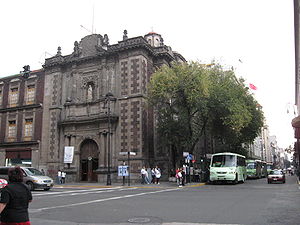- Church of San Bernardo, Mexico City
-
Church of San Bernardo
Church of San Bernardo in Mexico CityLocation Mexico City Country Mexico Denomination Roman Catholic History Consecrated 1690 The Church of San Bernardo (Spanish: Iglesia de San Bernardo) stands at the corner of Avenida 20 de Noviembre and Venustiano Carranza Street just south of the Zocalo or main plaza of Mexico City. It was part of a convent of the same name that was founded in 1636, but was closed along with all convents and monasteries during the La Reforma period in 1861. Currently, only the church remains of the convent complex.[1]
The church was part of a convent of the same name which was sponsored by Juan Marquez de Orozco, a merchant who left his fortune to the Church with the stipulation that the money be used to found a convent for the Cistercian Order.[1] After Orozo’s death, José Retes de Largacha, Marquis of San Jorge, became the convent’s benefactor, purchasing the land for the church and convent. .[2] The convent was founded in 1636, by three of Orozco’s sisters and two other nuns, all from the Convent of Regina Coeli. .[1] The church was consecrated in 1690. In the 18th century, Miguel de Berrio y Saldivar, Count of San Mateo Valparaiso, took charge of repair work, leading to the use of geometrically-cut tezontle stone. The church was rededicated in 1777 .[2]
During the Reform period under Benito Juárez, all monasteries and convents were closed and this convent was demolished, except for the church. Its demolition paved the way of the opening of the street that would become 20 de Noviembre.[1]
Much of the façade’s surface is covered in tezontle a reddish, porous volcanic rock.[1] The decoration of the main façade of the church is what is called a “discreet” expression of the Baroque style, meaning not all of the surface is covered in decoration, but the sections which do have them are done in that style. The work done on this church has been compared to the filigree done by silversmiths. Where the Baroque style really stands out is the profusion of decoration surrounding the niches; one of which holds an image of Saint Bernard and the other a figure of the Virgin of Guadalupe. This figure used to be on the opposite side of the church/convent, but when it was dismantled, it was moved here. The main architect of the church was Juan Zepeda .[2]
On the exterior is a bronze plaque that reads “Las Religiosas Concepcionistas del Convento del Dulcísimo Nombre de María del Glorioso San Bernardo. Fundado el 30 III 1636 in este Lugar, Celebramos 350 años de su fundación, 1986” [1]
The Church's interior has a neo-classic altar.[1]
References
Landmarks and historic buildings of Mexico City Centro Zócalo
and immediate vicinitySchools and colleges Universidad del Claustro de Sor Juana · Academia Mexicana de la Historia · Academy of San Carlos · Colegio de San Ignacio de Loyola Vizcaínas · Antigua Escuela de Economía · Colegio Nacional · Colegio de Minería
Government buildings Old Customs Building · Chamber of Deputies · Departamento de Estadistica Nacional · Secretariat of Public Education Main Headquarters · Senate building · Supreme Court building · Palace of the Marqués del Apartado · Library of the Congress of Mexico
Religious buildings Nuestra Señora de Loreto Church · Church of San Francisco · Church of Nuestra Señora de Valvanera · Church of San Bernardo · Ex Temple of Corpus Christi · La Enseñanza Church · La Merced Cloister · La Santisima Church · Temple and Ex-convent of Jesus Maria · Church of San Juan de Dios · Santa VeraCruz Church · Regina Coeli Church · Santa Teresa la Antigua · Temple of San Pablo el Nuevo · Church of Santo Domingo · Temple of Saint Augustine · Temple of San Felipe Neri "La Profesa" · Church of La Soledad
Museums San Ildefonso College · Caricature Museum · Franz Mayer Museum · Museum of the City of Mexico · Interactive Museum of Economics · Museo de Arte Popular · José Luis Cuevas Museum · Palace of the Inquisition (Museum of Mexican Medicine) · Mexican Army Museum · Museo Nacional de Arte · Museo de Charrería · Museo de la Estampa · Museo de Estanquillo · Museum Archive of Photography · Museum of Secretaría de Hacienda y Crédito Público · San Pedro y San Pablo College (Museum of Light) · House of the First Print Shop in the Americas · National Museum of Cultures · Borda House, Mexico City
Palaces Castillo de Chapultepec · Palace of Iturbide · Palacio de Bellas Artes · Palacio de Correos de Mexico · Casa de los Azulejos · Houses of the Mayorazgo de Guerrero · Palace of the Marqués del Apartado · Palacio de la Autónomia
Historic houses Tlaxcala House · House of Count de la Torre de Cossio · House of the Marquis of Uluapa · House of the Count de la Torre Cosío y la Cortina
Other Plaza Garibaldi · Antigua Escuela de Jurisprudencia · Chinatown (Barrio Chino) · Tlaxcala House · Garden of the Triple Alliance · Centro Cultural de España (Mexico City) · INAH Building · Abelardo L. Rodriguez Market · La Merced Market · Lirico Theatre · Alameda Park · Plaza Santo Domingo · Teatro Hidalgo · Teatro de la Ciudad · Torre Latinoamericana · Hospital de Jesús Nazareno · Tlaxcoaque
Coordinates: 19°25′50.81″N 99°8′1.88″W / 19.4307806°N 99.1338556°W
Categories:- Buildings and structures in Mexico City
- Roman Catholic churches in Mexico
- Landmarks in Mexico City
- Churches in Mexico City
- Roman Catholic Church in Mexico
- History of Mexico City
- 1636 establishments
- Colonial Mexico
- Baroque architecture
Wikimedia Foundation. 2010.

